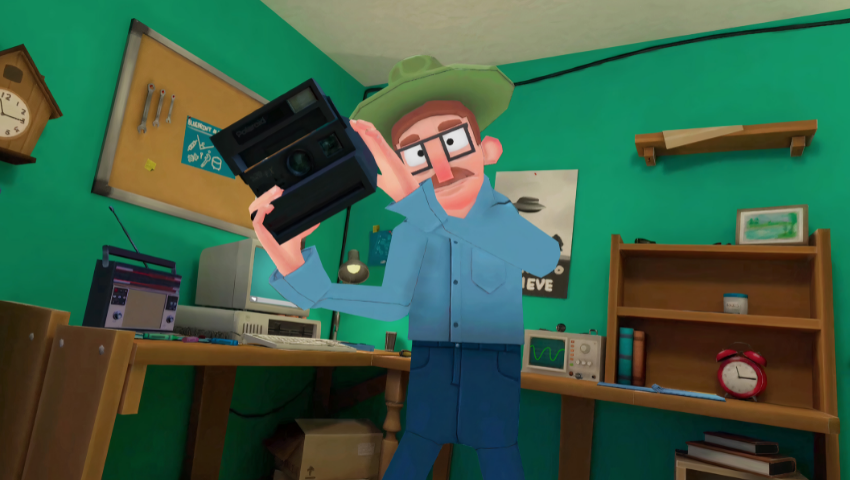Courtesy of Tinker Studio
Participants will be making memories at SIGGRAPH 2021 in more ways than one. Immersive Pavilion selection “Tinker” offers a virtual reality experience that focuses on a grandchild and their grandfather, who is suffering from Alzheimer’s disease. Through a series of vignettes, the participant witnesses the grandfather’s cognitive decline in the effort to finish a joint passion project together.
In honor of Alzheimer’s & Brain Awareness Month, we caught up with creator Lou Ward to learn more about the inspiration behind “Tinker,” how it strives to reduce the stigma associated with neurodegenerative disease, how the immersive experience can help participants better understand the gravity of Alzheimer’s disease, and what it means to create memories with the ones we love.
SIGGRAPH: Share some background about “Tinker.” You note that this story was inspired by your own grandfather’s experience with Alzheimer’s disease. How did you decide to pursue creating this experience in VR?
Lou Ward (LW): For my senior project at Savannah College of Art and Design (SCAD), I created a 2D animated film about the relationship between my grandfather and me, and how he taught me to tinker. This was our first iteration of the story. After I tried the Oculus Rift DK2, I knew I wanted to translate this film into a virtual reality (VR) experience for an audience to not just watch, but to experience.
What I went through with my grandfather was very personal, yet I know it is what so many people experience when they have a loved one suffering from a neurodegenerative disease. I wanted to share not only what I felt but also the story of every person going through this experience, whether that is a loved one experiencing Alzheimer’s disease, getting older, or even losing their memories.
Memories make us who we are — when they disappear, what happens to us? My grandfather was known for his intelligence. He was a computer engineer, so when he started to lose his memory, it was difficult to experience. My goal as a director is to spread awareness and reduce the stigma associated with neurodegenerative disease. We accomplish that by allowing each participant to “walk in my shoes”; however, the story intentionally becomes very much the participant’s own from the beginning. We want them to feel that connection through the authentic, embodied story-living inside VR.
Each experience is personalized so that every participant becomes the main character of the story and the grandfather, portrayed by improvisational actor Randy Dixon, makes the participant feel that the story is their own. VR allows the participant to connect with the grandfather and the story like never before through unscripted dialogue, playing with toys and games together, and sharing bespoke experiences. We even have about 10 “firefly” viewers who can walk around the experience without being seen or heard so that they may also be a part of the story. We often found that these viewers had a much more personal connection to the story through viewing it than we ever anticipated. Although this experience is based on my personal story, “Tinker” really becomes everyone’s story. There is power in that transcendent connection we all have with one another.
SIGGRAPH: Tell us about the process of creating “Tinker” for VR. What was the biggest challenge you faced?
LW: “Tinker” began its journey out of the Seattle XR tech scene five years ago. From the VR/AR Meetup I helped co-found to Seattle hackathon teams and colleagues from Microsoft, we evolved our local team into a full-fledged studio, bringing on talent from VR Philippines to make this vision come to life.
Our biggest hurdle was evolving with the ever-changing technology to execute the authentic, real-time performance we had in mind. From changing VR headset types to motion capture software and gear, we had to constantly adapt to the revolving door of the best technology out there to make our story reach the highest fidelity possible. We overcame big tech companies deprecating our mocap middleware software to pivoting to custom, nuanced facial-gesture technology and custom frameworks to ensure that we were delivering the best performance possible in real-time production for our participants. We started working with a live improvisational actor over five years ago to ensure the dynamic, unscripted, and organic experience between characters took place virtually and that the technology met the needs of our vision. Whenever it didn’t, we created our own!
SIGGRAPH: Why was it important that “Tinker” be an interactive experience?
LW: There’s no better way to fully understand a story than to experience it yourself. The best way to share “Tinker” was to have our participants wear a VR headset and step into the virtual world of the grandfather who develops Alzheimer’s disease over the course of five vignettes, which you experience from a very real, first-person perspective. Those five scenes allow you to develop an authentic connection with the grandfather, to play with him, laugh with him, talk to him about life. And you create new memories in the process. Our memories are linked to emotions and spaces — if we can create those moments of imprinting, we can allow for real connection to occur within the narrative. This is something you can’t get from a 2D film. In this story, you drive the narrative forward, you make the decisions, and you are essentially the center of the story. Improvisation and unscripted narrative make the connection between characters even more real.
SIGGRAPH: Describe the relationship between the grandchild and grandfather in the story. What experience does the relationship create for the viewer?
LW: The relationship between the grandchild and grandfather is different in every performance. It is up to the participant. We had one memorable participant during our Sundance premiere who truly embodied the concerned and doting grandchild. They fully stepped into that role and were trying to help the grandfather cope. We had a lot of feedback from viewers that they had a very real and transformative experience watching the performance take place. Even though they weren’t the grandchild, they understood those feelings or related to a similar experience from their own lives. Being a passive viewer who could neither be seen nor heard allowed them to let their guard down and experience every moment in the scene.
SIGGRAPH: What role does memory play in the interactive experience?
LW: We want participants and viewers to create real memories from their time inside “Tinker.” Just because it is inside VR does not mean that the connection to the grandfather or the story can’t be real. There is a degree of tangibility to the experience, yet in this tangibility there is fragility. Ultimately, the grandfather starts to forget the very memories you created together even though you remember every moment. This is what happens with Alzheimer’s disease and, more often than not, with neurodegenerative disease, we don’t know until time reveals if we are the one chosen to remember or forget. The most important part of this experience, however, is creating those memories and holding on to the hope that there will be a cure one day. We hope this experience inspires increased awareness and understanding of the disease to promote real and lasting change for the future.
SIGGRAPH: What do you hope participants take away from “Tinker”?
LW: Memories define who we are and how we construct our reality. For me, it was the process of my grandfather losing his greatest strength. “Tinker” lays the bones for what it’s like losing someone to Alzheimer’s disease by giving participants a firsthand, interactive, story-living experience to create empathy and hopefully provide support for people going through it in real life. We hope that it not only inspires awareness and understanding for others but also instills the importance of spending time with those we care about and the value of making memories. It is up to the participant what they take away from the experience.
SIGGRAPH: Alzheimer’s disease is a devastating condition that affects many families around the world. How does “Tinker” raise awareness for this disease?
LW: “Tinker” allows participants and viewers to understand the disease from a first-person, story-living perspective. We hope that it inspires understanding in those afflicted by the disease, as well as their families, friends, and caretakers. Our next step with “Tinker” is to transpose our embodied story-living experience into a healthcare training and educational tool for caregivers.
SIGGRAPH: In addition to being a month to celebrate Pride in the U.S., June is Alzheimer’s & Brain Awareness Month. Do you have recommendations for Alzheimer’s resources, upcoming events, or technology to share with the SIGGRAPH community?
LW: Groups like Hilarity for Charity and ADDF have been doing great work on the ground floor to help those afflicted with the disease and their families. We support them and follow groups like the Alzheimer’s Association, The Allen Institute, and other researchers and institutions exploring Alzheimer’s and other neurodegenerative diseases. There continue to be advancements in Alzheimer’s medicine and cognitive health, and we hope to support the teams who are part of the process while also increasing awareness, promoting understanding, and providing support to those experiencing the disease every day.
SIGGRAPH: What are you most looking forward to about SIGGRAPH 2021?
LW: We can’t wait to share what we’ve been working on with the community and, most importantly, to learn and grow from the SIGGRAPH community.
Make memories at SIGGRAPH 2021. Register now to join us online, 9–13 August.
 Lou Ward is an immersive director and founder of Tinker Studio. A SCAD alumni and former Microsoft UX designer, Ward brings their talents in design to the world of interactive gameplay and innovative storytelling in extended reality. Ward co-founded the Seattle VR/AR Meetup, and their studio has won several Seattle hackathons. Ward has been selected twice for the Oculus Launchpad Program as well as Oculus Start and is a 2021 Oculus Launchpad grant recipient for “Tinker.” In addition to being an advocate for inclusive design practices in game design, Ward also is an advocate for Alzheimer’s disease awareness.
Lou Ward is an immersive director and founder of Tinker Studio. A SCAD alumni and former Microsoft UX designer, Ward brings their talents in design to the world of interactive gameplay and innovative storytelling in extended reality. Ward co-founded the Seattle VR/AR Meetup, and their studio has won several Seattle hackathons. Ward has been selected twice for the Oculus Launchpad Program as well as Oculus Start and is a 2021 Oculus Launchpad grant recipient for “Tinker.” In addition to being an advocate for inclusive design practices in game design, Ward also is an advocate for Alzheimer’s disease awareness.



